(完整版)初中英语语法一般现在时专题
(完整版)初中语法一般现在时和现在进行时讲解、练习含答案

一般现在时:一、定义与讲解:一般现在时表示经常或习惯性的动作或一般性事实。
,也可表示现在的状态或主语具备的性格和能力。
通常与副词every day(每天),always(总是),usually(通常),often (经常)sometimes(有时),等时间状语连用。
例:(1)表示事物或人物的特征、状态。
The sky is blue.天空是蓝色的。
Mary’s father is an English teacher. 玛丽的爸爸是一名英语老师。
(2)表示经常性或习惯性的动作。
I get up at six every day.我每天六点起床。
She plays sports every day. 她每天都做运动。
(3)表示客观现实。
The table has four legs.桌子有四条腿。
There are 50 students in my class. 我们班有50个学生。
(4)表示客观真理,科学原理,自然现象,等客观事实或格言谚语等。
The sun rises in the east every day.太阳每天从东方升起。
The earth goes around the sun.地球绕着太阳转。
(5)表示平日的喜好。
I like bananas. We don’t like vegetables.He likes ice cream. She doesn’t like strawberries.二.只有主语在第三人称单数时用动词的“三单形式”,其他人称用动词原形。
★动词三单形式的变化规则:1.(1)多数直接在动词词尾加-s.play — plays like — likesask---asks work---works get---gets call---calls(2)以字母s, x, ch, sh或o结尾的动词,在词尾直接加-es.watch---watches wish---wishes do---does go---goes (3)以“辅音字母加 - y”结尾的动词,要先变y为i再加-es.try---tries study---studies cry---cries fly---flies2.不规则变化:be---- is have----has三、一般现在时的句子转换:(1)变一般疑问句:当句子中有be动词或情态动词时,则把be动词或情态动词(can,could等)提到主语的前面,(口诀:一调二变三问号);(2)变否定句:在be动词或情态动词后面直接加not变成否定句. (be后not 莫忘记)例:①陈述句:She is my sister..疑问句→ Is she your sister? Yes, I am./ No, I’m not.否定句→ She is not my sister.②陈述句:I can play soccer.疑问句→ Can you play soccer? Yes,Ican./ No, I can’t.否定句→ I can not /can’t play soccer.★注意:对一般疑问句的回答:一般用什么问就用什么来回答。
初中英语语法一般现在时
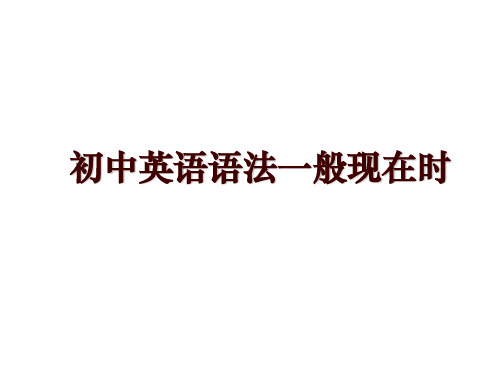
给出下列动词的第三人称单数
• talk__t_a_lk_s_forget__f_o_rg_e__ts_hope_h__o_p_e_s • stop__s_t_o_p_sperform_p_e__rf_o_r_m_s_play_____p_lays • say___s_a_y_sbuy__b_u_y_s_ worry____w__o_rr_ies
• 3.Li Ping has a soccer ball.(变为一般疑问句)
• Do_e_s__Li Ping ha_v_e__a soccer ball?
• 4.Does she have a CD?(做肯定回答)
• Yes,shedoe_s___ .
• 5.He has a baseball.(变否定句)
15. 她喜欢游泳。 She likes swimming. 16. 她是一个美丽的女孩。 She is a beautiful girl. 17. 她不喜欢弹钢琴。 She doesn't like playing the piano. 18. 她住在国王街87号。 She lives at 87 King Street. 19. 她是中国人。 She is Chinese.
• fly__f_li_e_s_study_s_t_u_d_ie_s_like_____lik_e_s • makem__a_k_e_s_take_t_a_k_e_s_love_____lo_v_es • recite_r_e_c_i_te_s_becomeb__e_c_o_m_e__scome_c_o_m__e_s • drive__d_r_iv_e_s_shine__s_h_in__e_sleave___le_a_v_e_s • wake__w_a_k_e_s_ride___r_id_e_s_write___w_r_it_e_s
(完整版)初中英语语法一般现在时专项讲解及练习
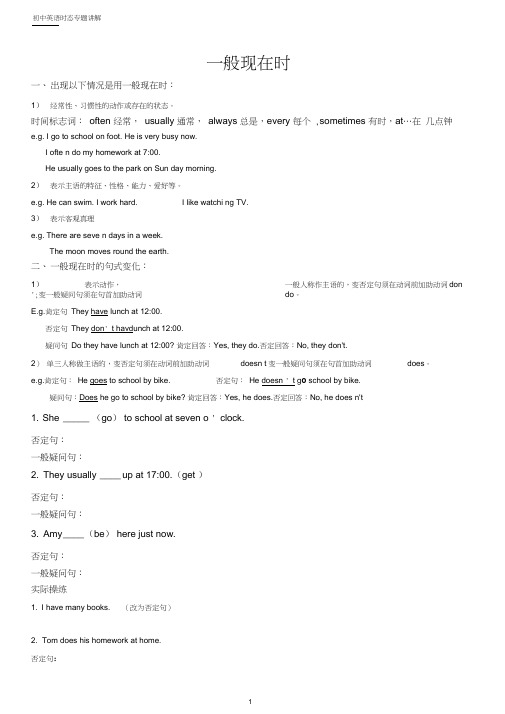
一般现在时一、出现以下情况是用一般现在时:1)经常性、习惯性的动作或存在的状态。
时间标志词:often 经常,usually 通常,always 总是,every 每个 ,sometimes 有时,at…在几点钟e.g. I go to school on foot. He is very busy now.I ofte n do my homework at 7:00.He usually goes to the park on Sun day morning.2)表示主语的特征、性格、能力、爱好等。
e.g. He can swim. I work hard. I like watchi ng TV.3)表示客观真理e.g. There are seve n days in a week.The moon moves round the earth.二、一般现在时的句式变化:1)表示动作,一般人称作主语的,变否定句须在动词前加助动词don ';变一般疑问句须在句首加助动词do。
E.g.肯定句They have lunch at 12:00.否定句They don' t havdunch at 12:00.疑问句Do they have lunch at 12:00? 肯定回答:Yes, they do.否定回答:No, they don't.2)单三人称做主语的,变否定句须在动词前加助动词doesn t变一般疑问句须在句首加助动词does。
e.g.肯定句:He goes to school by bike. 否定句:He doesn ' t g o school by bike.疑问句:Does he go to school by bike? 肯定回答:Yes, he does.否定回答:No, he does n't1. She _____ (go) to school at seven o ' clock.否定句:一般疑问句:2. They usually ____ up at 17:00.(get )否定句:一般疑问句:3. Amy ____ (be) here just now.否定句:一般疑问句:实际操练1. I have many books. (改为否定句)2. Tom does his homework at home.否定句:一般疑问句:3. Mingming usually waters the flowers.否定句: 一般疑问句4.Su Yang usually washes some clothes on Saturday.否定句:5. I usually play football on Friday after noon.否定句: 般疑问句:( )1. _____ you have a book? A. DoB. AreC. IsD. Have( )2. They ________ on a farm. A.are worki ngB. is workC. worki ngD. is worked()3. Does Peter like to watch TV? _________ .( )6. Where ' s my camera? I _____________ it.强化训练一、写出下列单词的第三人称单数形式clean _________ write ___________ guess _________ watch ___________cry _________ play ______________A. Yes, he likeB. No, he doe sn 'tC. Yes, he ' d likeD. No, he likes ()4. She doesn ' t her homework in the after noon. A. doing B. to do C. does D. do()5. HowMr. Brow n __________ to America?A. do, goB. is, goC. does, go1. My classmate ____ (know) the man on the bike.2. His sister usually _____ (go) to school at 7:00 am.C. can ' t find D. can ' t look at( )7. How he go to work? HeA. does; goB. do; goesC. do ; go ( )8.you usually late for school? No,A . Do; I am B. Does ;not( )9.she home at six every day?A . Is , leave B. Does ,leave( )10. Mr. Yang En glish this term.A . teaches our B. teaches usto work by bike.D.does; goesC. Are ; I ' m notD. Are ; I aren 'tC. Is , leavesD. Does , leftC. teachs usD. teach ourA. am not findingB. am not see ing 三•用所给动词的适当形式填空。
(完整版)一般现在时的语法总结
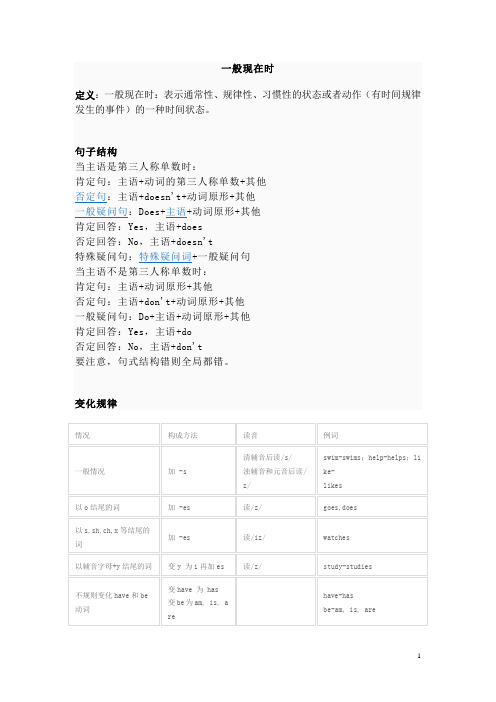
一般现在时定义:一般现在时:表示通常性、规律性、习惯性的状态或者动作(有时间规律发生的事件)的一种时间状态。
句子结构当主语是第三人称单数时:肯定句:主语+动词的第三人称单数+其他否定句:主语+doesn't+动词原形+其他一般疑问句:Does+主语+动词原形+其他肯定回答:Yes,主语+does否定回答:No,主语+doesn't特殊疑问句:特殊疑问词+一般疑问句当主语不是第三人称单数时:肯定句:主语+动词原形+其他否定句:主语+don't+动词原形+其他一般疑问句:Do+主语+动词原形+其他肯定回答:Yes,主语+do否定回答:No,主语+don't要注意,句式结构错则全局都错。
变化规律具体运用1.表示经常的或习惯性的动作,常与表示频率的时间状语连用。
时间状语: always, usually,regularly,everymorning/night/evening/day/week/year,often,sometimes,occasionally ,from time to time,twice a week,rarely,seldom,once a month, hardly, ever,never.e.g. I leave home for school at 7:00 every morning.2.表示主语具备的性格、能力、特征和状态。
e.g. I don't want so much.Ann Wang writes good English but does not speak well.比较:Now I put the sugar in the cup.I am doing my homework now.3.表示客观事实和普遍真理。
e.g The earth moves around the sun.Shanghai lies in the east of China.4.在时间状语从句和条件状语从句中,常用一般现在时代替将来时。
初中英语语法总复习初中英语语法一般现在时专题讲解

初中英语语法总复习初中英语语法一般现在时专题讲解初中英语语法一般现在时专题讲解一般现在时:表示通常性、规律性、习惯性的状态或者动作(有时间规律发生的事件)的一种时间状态。
[基本结构]一般现在时的基本结构一般现在时除主语是第三人称单数时谓语动词要加s外,一律用动词原形。
例句:I go to school at 6 every morning. 每天早上我七点去上学。
Summer follows spring. 春天之后是夏天。
The sun rises in the east. 太阳从东方升起。
I learned that the earth goes around the sun when I was in primary school. 我在小学就学过地球是围绕太阳转的。
Pride goes before a fall. 骄者必败。
[时态详解]一般现在时最详细解析1) 描述当前时间内经常出现、反复发生的动作或存在的状态。
在这种情景中,句子常带有表示频率的时间状语:always ,everyday , often , once a week (month , year , etc.) , sometimes , seldom , usually等等,以表示句中的动作或状态是习惯性的、经常性的。
例如:They raise ducks as a sideline .他们以养鸭为副业。
She doesn't often write to her family, only once a month. 她不常给家里写信,仅一月一封而已。
I cycle to work every day .我每天骑自行车上班。
It seldom rains here .这儿很少下雨。
2)仅为了描述状态、性质、特征、能力等等。
这里的目的是为了“描述现阶段的动作或状态",其重点"不是强调动作发生的时间、或进行的状态"。
初中英语语法八大时态总结完整版
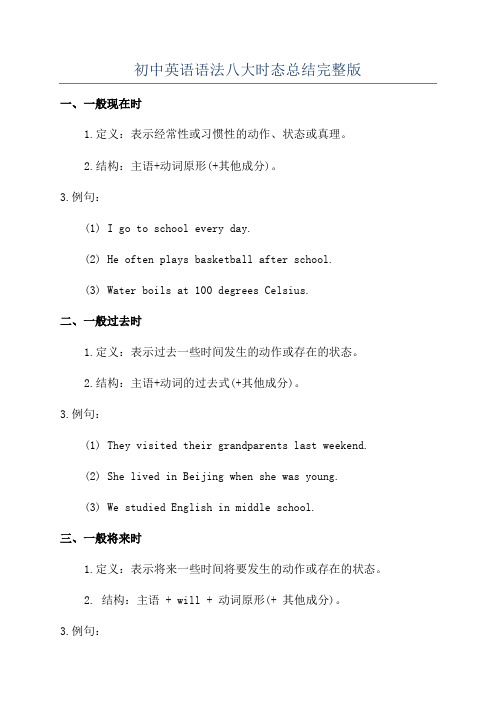
初中英语语法八大时态总结完整版一、一般现在时1.定义:表示经常性或习惯性的动作、状态或真理。
2.结构:主语+动词原形(+其他成分)。
3.例句:(1) I go to school every day.(2) He often plays basketball after school.(3) Water boils at 100 degrees Celsius.二、一般过去时1.定义:表示过去一些时间发生的动作或存在的状态。
2.结构:主语+动词的过去式(+其他成分)。
3.例句:(1) They visited their grandparents last weekend.(2) She lived in Beijing when she was young.(3) We studied English in middle school.三、一般将来时1.定义:表示将来一些时间将要发生的动作或存在的状态。
2. 结构:主语 + will + 动词原形(+ 其他成分)。
3.例句:(1) I will go to the park tomorrow.(3) We will have a party next week.四、现在进行时1.定义:表示现在正在进行的动作。
2. 结构:主语 + am/is/are + 动词-ing(+ 其他成分)。
3.例句:(1) She is reading a book right now.(2) They are playing soccer in the park.(3) We are having dinner at the moment.五、过去进行时1.定义:表示过去一些时间正在进行的动作。
2. 结构:主语 + was/were + 动词-ing(+ 其他成分)。
3.例句:(1) He was watching TV at 8 o'clock last night.(2) They were traveling in Europe during summer vacation.(3) We were studying when the phone rang.六、将来进行时1.定义:表示将来一些时间正在进行的动作。
初中英语语法八大时态总结(完整版)
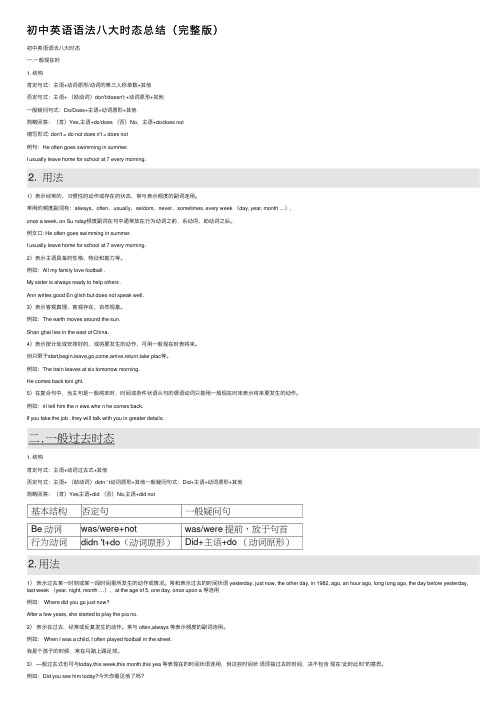
初中英语语法⼋⼤时态总结(完整版)初中英语语法⼋⼤时态⼀.⼀般现在时1. 结构肯定句式:主语+动词原形/动词的第三⼈称单数+其他否定句式:主语+ (助动词)don't/doesn't +动词原形+其他⼀般疑问句式:Do/Does+主语+动词原形+其他简略回答:(肯)Yes,主语+do/does (否)No,主语+do/does not缩写形式: don't = do not does n't = does not例句:He often goes swimming in summer.I usually leave home for school at 7 every morning.1)表⽰经常的、习惯性的动作或存在的状态,常与表⽰频度的副词连⽤。
常⽤的频度副词有:always、often、usually、seldom、never、sometimes, every week (day, year, month …),once a week, on Su nday频度副词在句中通常放在⾏为动词之前,系动词、助动词之后。
例⼥⼝: He often goes swimming in summer.I usually leave home for school at 7 every morning.2)表⽰主语具备的性格、特征和能⼒等。
例如:All my family love football .My sister is always ready to help others .Ann writes good En glish but does not speak well.3)表⽰客观真理、客观存在、⾃然现象。
例如:The earth moves around the sun.Shan ghai lies in the east of China.4)表⽰按计划或安排好的,或将要发⽣的动作,可⽤⼀般现在时表将来。
初中英语语法知识之一般现在时
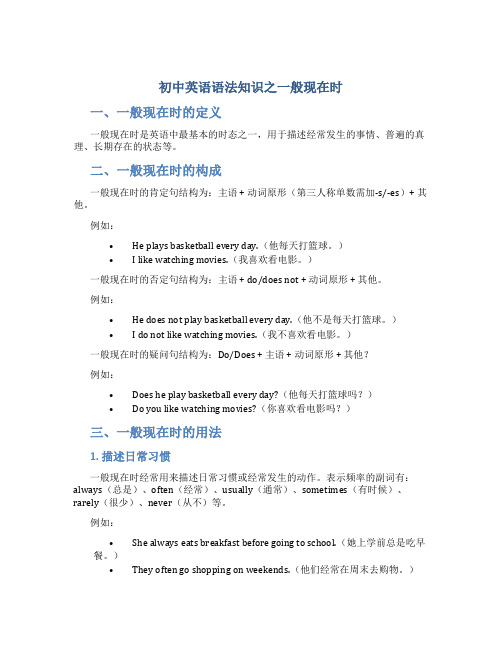
初中英语语法知识之一般现在时一、一般现在时的定义一般现在时是英语中最基本的时态之一,用于描述经常发生的事情、普遍的真理、长期存在的状态等。
二、一般现在时的构成一般现在时的肯定句结构为:主语 + 动词原形(第三人称单数需加-s/-es)+ 其他。
例如:•He plays basketball every day.(他每天打篮球。
)•I like watching movies.(我喜欢看电影。
)一般现在时的否定句结构为:主语 + do/does not + 动词原形 + 其他。
例如:•He does not play basketball every day.(他不是每天打篮球。
)•I do not like watching movies.(我不喜欢看电影。
)一般现在时的疑问句结构为:Do/Does + 主语 + 动词原形 + 其他?例如:•Does he play basketball every day?(他每天打篮球吗?)•Do you like watching movies?(你喜欢看电影吗?)三、一般现在时的用法1. 描述日常习惯一般现在时经常用来描述日常习惯或经常发生的动作。
表示频率的副词有:always(总是)、often(经常)、usually(通常)、sometimes(有时候)、rarely(很少)、never(从不)等。
例如:•She always eats breakfast before going to school.(她上学前总是吃早餐。
)•They often go shopping on weekends.(他们经常在周末去购物。
)2. 表达客观事实或普遍真理一般现在时也被用来表达客观事实或普遍真理。
例如:•The Earth revolves around the sun.(地球绕太阳运行。
)•Water boils at 100 degrees Celsius.(水在100摄氏度沸腾。
初中英语一般现在时知识点
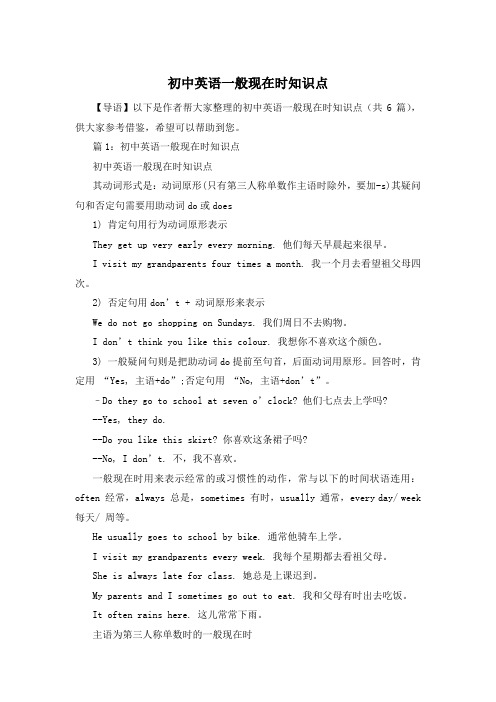
初中英语一般现在时知识点【导语】以下是作者帮大家整理的初中英语一般现在时知识点(共6篇),供大家参考借鉴,希望可以帮助到您。
篇1:初中英语一般现在时知识点初中英语一般现在时知识点其动词形式是:动词原形(只有第三人称单数作主语时除外,要加-s)其疑问句和否定句需要用助动词do或does1) 肯定句用行为动词原形表示They get up very early every morning. 他们每天早晨起来很早。
I visit my grandparents four times a month. 我一个月去看望祖父母四次。
2) 否定句用don’t + 动词原形来表示We do not go shopping on Sundays. 我们周日不去购物。
I don’t think you like this colour. 我想你不喜欢这个颜色。
3) 一般疑问句则是把助动词do提前至句首,后面动词用原形。
回答时,肯定用“Yes, 主语+do”;否定句用“No, 主语+don’t”。
–Do they go to school at seven o’clock? 他们七点去上学吗?--Yes, they do.--Do you like this skirt? 你喜欢这条裙子吗?--No, I don’t. 不,我不喜欢。
一般现在时用来表示经常的或习惯性的动作,常与以下的时间状语连用:often 经常,always 总是,sometimes 有时,usually 通常,every day/ week 每天/ 周等。
He usually goes to school by bike. 通常他骑车上学。
I visit my grandparents every week. 我每个星期都去看祖父母。
She is always late for class. 她总是上课迟到。
My parents and I sometimes go out to eat. 我和父母有时出去吃饭。
初中英语语法总结一般现在时
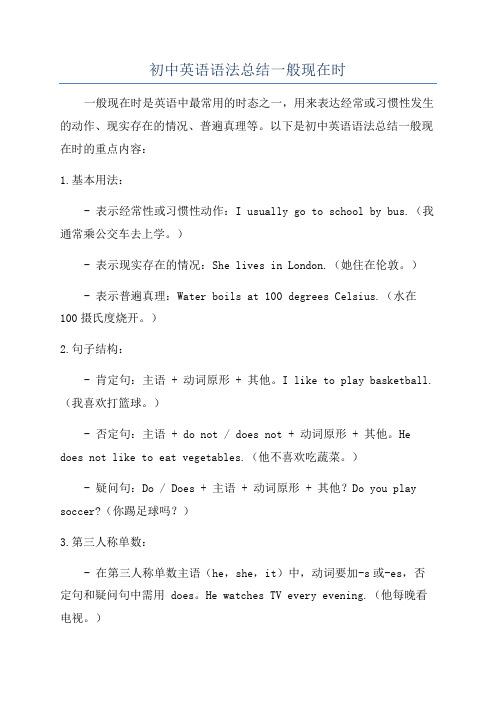
初中英语语法总结一般现在时一般现在时是英语中最常用的时态之一,用来表达经常或习惯性发生的动作、现实存在的情况、普遍真理等。
以下是初中英语语法总结一般现在时的重点内容:1.基本用法:- 表示经常性或习惯性动作:I usually go to school by bus.(我通常乘公交车去上学。
)- 表示现实存在的情况:She lives in London.(她住在伦敦。
)- 表示普遍真理:Water boils at 100 degrees Celsius.(水在100摄氏度烧开。
)2.句子结构:- 肯定句:主语 + 动词原形 + 其他。
I like to play basketball.(我喜欢打篮球。
)- 否定句:主语 + do not / does not + 动词原形 + 其他。
He does not like to eat vegetables.(他不喜欢吃蔬菜。
)- 疑问句:Do / Does + 主语 + 动词原形 + 其他?Do you play soccer?(你踢足球吗?)3.第三人称单数:- 在第三人称单数主语(he,she,it)中,动词要加-s或-es,否定句和疑问句中需用 does。
He watches TV every evening.(他每晚看电视。
)- 一些以s, sh, ch, x, o结尾的单词,需要在动词后加-es,如:misses,washes,watches。
4.频率副词:- 频率副词通常放在动词之前,用于修饰动词。
例如:She always helps others.(她总是帮助别人。
)5.现在进行时与一般现在时的区别:- 现在进行时表示现在正在发生的动作,一般与现在时间状语连用,或表示现阶段的临时情况。
例如:I am studying for the exam.(我正在准备考试。
- 一般现在时表示经常性、习惯性的动作或客观存在的状态。
例如:I usually play soccer on weekends.(我通常在周末踢足球。
一般现在时知识点详解(初中英语专题复习) (8)
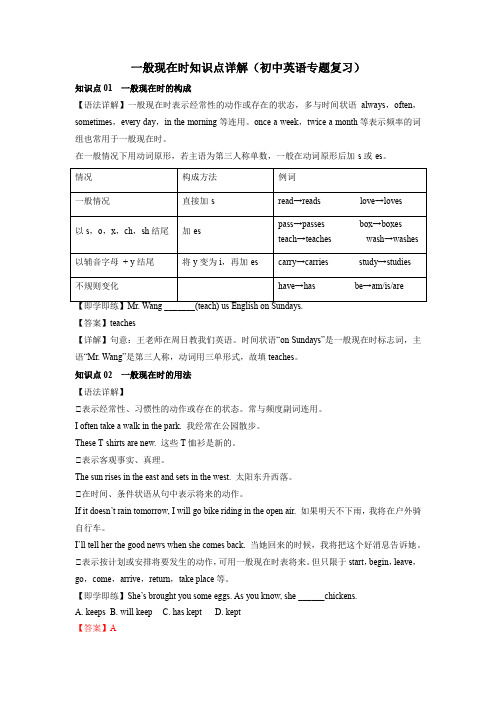
一般现在时知识点详解(初中英语专题复习)知识点01 一般现在时的构成【语法详解】一般现在时表示经常性的动作或存在的状态,多与时间状语always,often,sometimes,every day,in the morning等连用。
once a week,twice a month等表示频率的词组也常用于一般现在时。
在一般情况下用动词原形,若主语为第三人称单数,一般在动词原形后加-s或-es。
【答案】teaches【详解】句意:王老师在周日教我们英语。
时间状语“on Sundays”是一般现在时标志词,主语“Mr. Wang”是第三人称,动词用三单形式,故填teaches。
知识点02 一般现在时的用法【语法详解】①表示经常性、习惯性的动作或存在的状态。
常与频度副词连用。
I often take a walk in the park. 我经常在公园散步。
These T-shirts are new. 这些T恤衫是新的。
①表示客观事实、真理。
The sun rises in the east and sets in the west. 太阳东升西落。
①在时间、条件状语从句中表示将来的动作。
If it doesn’t rain tomorrow, I will go bike riding in the open air. 如果明天不下雨,我将在户外骑自行车。
I’ll tell her the good news when she comes back. 当她回来的时候,我将把这个好消息告诉她。
①表示按计划或安排将要发生的动作,可用一般现在时表将来。
但只限于start,begin,leave,go,come,arrive,return,take place等。
【即学即练】She’s brought you some eggs. As you know, she ______chickens.A. keepsB. will keepC. has keptD. kept【答案】A【详解】句意:她给你带了些鸡蛋。
(中考英语资料)初中英语语法八大时态总结(完整版)含答案
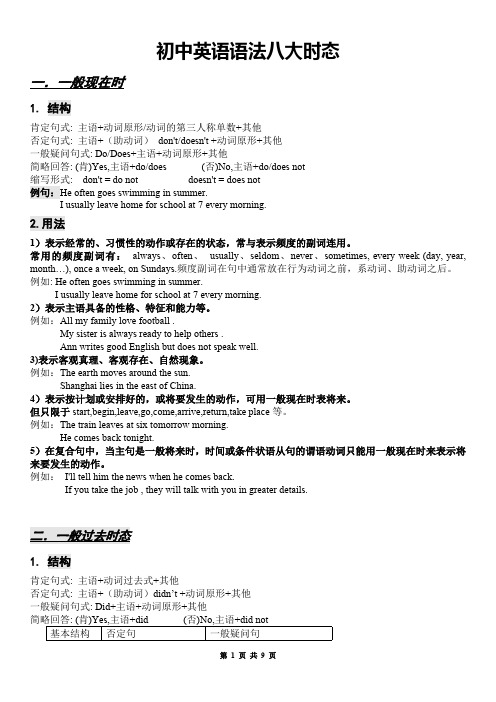
初中英语语法八大时态一.一般现在时1. 结构肯定句式: 主语+动词原形/动词的第三人称单数+其他否定句式: 主语+(助动词)don't/doesn't +动词原形+其他一般疑问句式: Do/Does+主语+动词原形+其他简略回答: (肯)Yes,主语+do/does (否)No,主语+do/does not缩写形式: don't = do not doesn't = does not例句:He often goes swimming in summer.I usually leave home for school at 7 every morning.2.用法1)表示经常的、习惯性的动作或存在的状态,常与表示频度的副词连用。
常用的频度副词有:always、often、usually、seldom、never、sometimes, every week (day, year, month…), once a week, on Sundays.频度副词在句中通常放在行为动词之前,系动词、助动词之后。
例如: He often goes swimming in summer.I usually leave home for school at 7 every morning.2)表示主语具备的性格、特征和能力等。
例如:All my family love football .My sister is always ready to help others .Ann writes good English but does not speak well.3)表示客观真理、客观存在、自然现象。
例如:The earth moves around the sun. Shanghai lies in the east of China.4)表示按计划或安排好的,或将要发生的动作,可用一般现在时表将来。
初中英语语法之-一般现在时
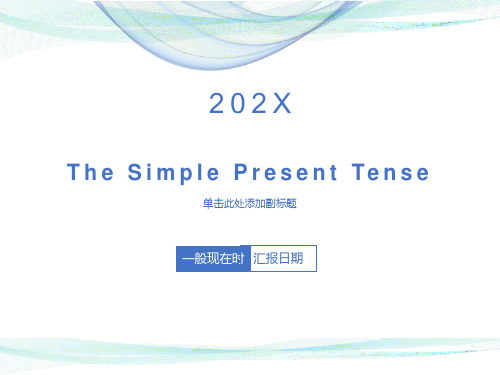
goes
does
5.特殊情况:
have be (am, are)
has is
三、句式结构
1. be 动词的一般现在时的句式: 肯定句:主语+be+表语(n., adj.等) e.g. He_____a worker. You ____ thirteen. They____ in the classroom. 否定句:主语+be+ not+表语. e.g. He_____ ( not be )a worker. You ______ ( not be )thirteen. They ______ ( not be )in the classroom.
月亮绕着地球转。
5、 在条件状语从句和时间状语从句中, 遵从主将从现。 例如: I'll tell him the news when he comes back. 他回来时,我将告诉他这个消息。 If you take the job , they will talk with you in greater details. 如果你接受这份工作,他们将和你谈谈细节。
stay
have
give
stays
has
do not
否定句:主语(非三单)+don't+v.原形+其他 4) I_________(not stay)at home on Saturdays. 5)They_________(not)have sports every day. 6) My parents ________ (not) give ten yuan to me every week. 主语(三单)+doesn't+v.原形+其他 He__________(not stay) at home on Saturdays. Lucy ___________(not have) sports every day.
初中英语语法中的一般现在时

足语
否定句
否定句的基本结构是“主语+助动词+not+谓语动词” 否定句中谓语动词要用原形 否定句中如果有be动词be动词要放在not之前 否定句中如果有情态动词情态动词要放在not之前
疑问句
一般现在时疑问句 的基本结构:助动 词do/does+主语 +动词原形+其他?
疑问句中助动词 do/does的选择: 主语是第三人称单 数时用does其他 人称用do。
疑问句中动词形式 的保持:动词保持 原形不要变形。
疑问句的语调:一 般现在时疑问句通 常使用升调。
04
一般现在时的特殊用法
表示习惯性或经常性发生的动作
定义:一般现在时可以用来表示习惯性或经常性发生的动作表示一种常态或习惯。
用法:通常与频率副词如“lwys”、“usully”、“often”等连用表示某个动作发生的频率 较高。
例子:I lwys get up t 6 o’clock in the morning. (我总是早上6点钟起床。)
注意:使用一般现在时表示习惯性或经常性发生的动作时要注意时态的正确性与事实相符。
表示现在的状态或情况
用于表示永恒的真理或事 实
用于表示格言或谚语
用于表示科学现象、自然 规律等
用于表示习惯性或经常性 的行为或状态
表示客观事实或普遍真理
描述科学事实或自然规律
描述普遍存在的现象或经验
添加标题
添加标题
描述历史事件或事实
添加标题
添加标题
用于新闻报道或文献描述
05
一般现在时与其它时态的区分
与一般过去时的区分
时间点不同:一 般现在时表示现 在的时间点而一 般过去时表示过 去的时间点。
初中英语语法八大时态总结(完整版)
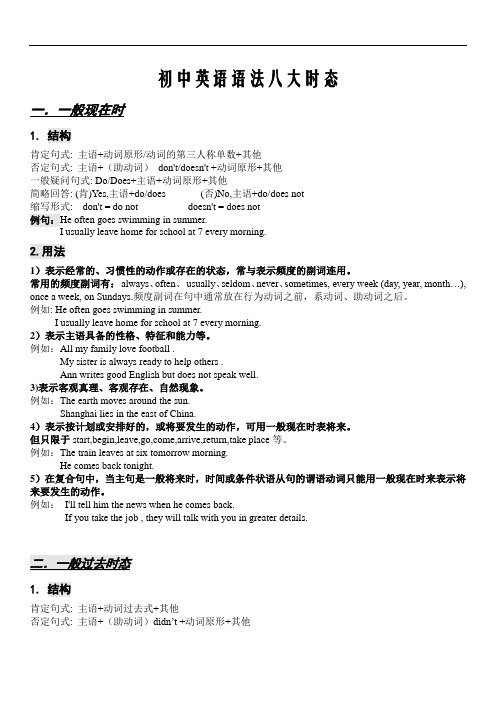
初中英语语法八大时态一.一般现在时1.结构肯定句式: 主语+动词原形/动词的第三人称单数+其他否定句式: 主语+(助动词)don't/doesn't +动词原形+其他一般疑问句式: Do/Does+主语+动词原形+其他简略回答: (肯)Yes,主语+do/does (否)No,主语+do/does not缩写形式: don't = do not doesn't = does not例句:He often goes swimming in summer.I usually leave home for school at 7 every morning.2.用法1)表示经常的、习惯性的动作或存在的状态,常与表示频度的副词连用。
常用的频度副词有:always、often、usually、seldom、never、sometimes, every week (day, year, month…), once a week, on Sundays.频度副词在句中通常放在行为动词之前,系动词、助动词之后。
例如: He often goes swimming in summer.I usually leave home for school at 7 every morning.2)表示主语具备的性格、特征和能力等。
例如:All my family love football .My sister is always ready to help others .Ann writes good English but does not speak well.3)表示客观真理、客观存在、自然现象。
例如:The earth moves around the sun.Shanghai lies in the east of China.4)表示按计划或安排好的,或将要发生的动作,可用一般现在时表将来。
初中英语语法: 时态:一般现在时(超详细讲解、重难点归纳+练习、测试)

一般现在时一、定义(什么情况会使用一般现在时?):1. 表示经常性或习惯性的动作。
如:I get up at six every day.__________________________________________________________________________________________________________________________ 2.表示不会随时间发生变化的客观事实。
如:The earth goes around the sun.__________________________________________________________________________________________________________________________ 二、时间标志词:①每……:every week (day/ year/ month);on Mondays②……一次:once a week (day /month/ year)③频度副词:sometimes;usually;often;never;sometimes三、句子结构:①含有be动词:主语+ be(am/ is/ are)+其它。
★am用于I,are用于you,is用于非I、非you、非复数时。
如:I am a girl.She is my sister.__________________________________________________________________________________________________________________________ 1. 否定句:主语+be(am/is/are)+not+其它。
如:He is a worker→ He is not a worker__________________________________________________________________________________________________________________________ 2. 一般疑问句:Be+主语+其它。
初中英语语法--一般现在时

1. Rona _d_o_e_sn_'_t_li_k_e_(not like)to drink orange soda. 2. Everybody __h_as___ (have) a chance to win. 3. Many children __a_r_e__(be) on the playground.
swim-swims;help-helps
大显身手oes
do
邮递员(postman) 游戏说明: 准备两套可拼成句子的单词卡 ,每组选派两名同学成为邮递 员,老师把两套卡打乱。看哪 组能最先拼出完整的句子,就 像邮递员要把每封信正确的送 到每一家一样,其余学生在下 面说句子。
I clean my room every day.
Here's no room to stand in.
bedroom 卧室 living room 客厅;起居室 dinning room 餐厅 reading room 阅览室 meeting room 会议室
head n. 头部; 头脑;首脑
but conj. 但是;而是;然而 prep. 除…以外
She likes reading, but I don't.
but可以连接两个并列成分, 用逗号隔开表转折,意为“但 是,然而”。
语法精讲
一般现在时 (语法) 表示通常性、习惯性的状 态或者动作的一种时间状态。
有实义动词的一般现在时变法
come on 加油 come from 来自于
think v. 想;认为
Tell me, what do you think of my idea? 告诉我,你认为我的主意怎么样?
初中英语语法一般现在时全解
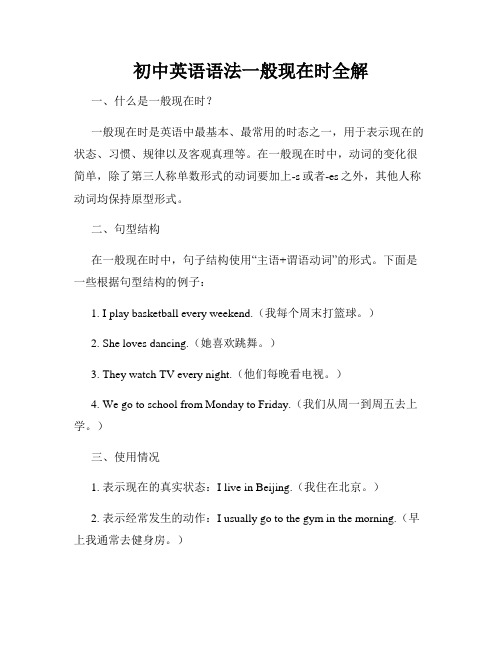
初中英语语法一般现在时全解一、什么是一般现在时?一般现在时是英语中最基本、最常用的时态之一,用于表示现在的状态、习惯、规律以及客观真理等。
在一般现在时中,动词的变化很简单,除了第三人称单数形式的动词要加上-s或者-es之外,其他人称动词均保持原型形式。
二、句型结构在一般现在时中,句子结构使用“主语+谓语动词”的形式。
下面是一些根据句型结构的例子:1. I play basketball every weekend.(我每个周末打篮球。
)2. She loves dancing.(她喜欢跳舞。
)3. They watch TV every night.(他们每晚看电视。
)4. We go to school from Monday to Friday.(我们从周一到周五去上学。
)三、使用情况1. 表示现在的真实状态:I live in Beijing.(我住在北京。
)2. 表示经常发生的动作:I usually go to the gym in the morning.(早上我通常去健身房。
)3. 表示普遍真理或客观规律:The sun rises in the east.(太阳从东方升起。
)4. 表示评论、陈述、想法等:I think English is an interesting subject.(我认为英语是个有趣的科目。
)四、一般现在时的注意事项1. 第三人称单数形式的动词要加上-s或者-es:He reads books every day.(他每天阅读书籍。
)但是要注意规则动词的变化,如do变为does。
2. 否定句需要在谓语动词前加上助动词do或does,并在其后加上not:I do not like coffee.(我不喜欢咖啡。
)She does not listen to music.(她不听音乐。
)3. 疑问句需要将助动词do或does提前至主语之前:Do you play tennis?(你打网球吗?)Does she go to school by bus?(她坐公交车去上学吗?)4. 当主语为第三人称单数时,疑问句直接用助动词does,无需加s:Does he like ice cream?(他喜欢冰淇淋吗?)五、总结一般现在时是英语中最基础、最常用的时态之一,用于表示现在的状态、习惯、规律以及客观真理等。
- 1、下载文档前请自行甄别文档内容的完整性,平台不提供额外的编辑、内容补充、找答案等附加服务。
- 2、"仅部分预览"的文档,不可在线预览部分如存在完整性等问题,可反馈申请退款(可完整预览的文档不适用该条件!)。
- 3、如文档侵犯您的权益,请联系客服反馈,我们会尽快为您处理(人工客服工作时间:9:00-18:30)。
##教育6T教材系列
一般现在时专题
时间:年月日老师电话:一、兴趣导入
猜一猜
人的一生有三天,是哪三天?
答案:昨天、今天、明天
二、学前测试
选择题。
( ) 1 We need some more____. Can you go and get some, please?
A. potato
B. potatos
C. potatoes
D. potatoe
( )2. What big____ the tiger has!
A. tooth
B. teeth
C. tooths
D. toothes
( ) 3. -Can we have some ___?
-Yes, please.
A. banana
B. oranges
C.apple
D. pear
( ) 4 Please remember to give the horse some tree___.
A. leafs
B. Leaves
C. leaf
D. leave
( )5. She hasn't brought ____ book with her. Will you lend her ____?
A. hers, your
B. her, your
C. hers, yours
D. her, yours
( )6. China is ______ old country with ______ long history.
A.an, a
B. a, a
C. an, the
D. an, an
( )7. My sister is a student of ________.
A. the First Class
B. Class One
C. One Class
D. Class First
( )8. The government of Chongqing is building ________ cheap and good houses for the people.
A. Thousand
B. Thousands
C. Thousand of
D. Thousands of
三、知识讲解
【No. 1】一般现在时的定义及构成
1.定义:一般现在时表示现在经常反复发生的动作、存在的状态或习惯性的动作。
2.构成:主语+动词原形+宾语
一般现在时用行为动词的原形,但第三人称单数作主语时,动词要用第三人称单数形式。
e.g.We like reading books.
He likes reading books.
3.动词第三人称单数形式的构成:
(1)一般的动词词尾+S。
play—plays stop—stops make—makes read--reads
(2)以为o,sh,ch,s,x结尾的动词+es.
teach—teaches watch--watches
(3)以辅音字母Y结尾的动词把Y变成i再+es。
fly—flies carry—carries study—studies worry--worries
(4)以o结尾的动词,在词尾加es.
go---goes do—does
不规则:
Have—has are--is
【No. 2】一般现在时的应用
(1)在实际应用中,一般现在时常与以下时间状语联用:always, usually, often, sometimes, every
week (day, year, month…), once a week, on Sundays ……
例句:He usually plays football on Sundays.他经常在星期日踢足球。
(2)没有时间状语,可以分以下四种类型:
A.be型
这一类型由be动词+名词、形容词、副词、代词、数词或介词短语等一起构成谓语,表示主语的个性、特征或状态。
如:
①I am a student. (主语+be动词+名词) 我是一名学生。
②They are hungry. (主语+be动词+形容词)他们肚子饿了。
③He is out. (主语+be动词+副词) 他出去了。
④That pen is mine. (主语+be动词+代词) 那支钢笔是我的。
⑤I am fifteen. (主语+be动词+数词) 我十五岁。
⑥The bike is under the tree. (主语+be动词+介词短语) 那辆自行车在树下。
B.do型
do型由行为动词充当谓语,表示经常性或习惯性的动作,其构成为“主语+动词原形或动词第三人称单数形式”。
如:
①I know it. 我知道这。
②He believes me. 他相信我。
C.there be型
there be型句子表示“存在”,其构成为“there be+主语+其他”,表示客观事实。
用法遵循“就近原则”,即主语是单数或并列主语中的第一个主语是单数,则用there is;主语是复数或并列主语中的第一个主语是复数,则用there are。
如:
(1)There is an eraser on the teacher's desk.(主语an eraser是单数) 讲桌上有一块橡皮擦。
(2)There is an orange,five apples and eight bananas in the bag.
(并列主语中的第一个主语an orange是单数)袋子里有一个橙子,五个苹果和八个香蕉。
D.情态动词型
情态动词型句子的构成为“主语+情态动词+动词原形”,情态动词和动词原形一起构成谓语,表示说话人对所叙述的动作或状态的看法。
如:
①He can speak a little English.(can+speak) 他会说一点儿英语。
②May I have a book, please?(may+have) 请问我能看一看吗?
【No. 3】一般现在时的变化
1.否定形式:首先找句子中有没有be动词(is, am或者are)或情态动词(can),如果有,只
要在be动词或情态动词后面加上not。
e.g.
He is not a teacher.
She can not speak English.
如果句子中没有be动词(is, am或者are)或情态动词(can)那么根据主语在后面加入don’t(you, I或者复数)或doesn’t(第三人称单数)。
e.g.
I don’t like English.
His father doesn’t exercise every day.
2.一般疑问句:首先找句子中有没有be动词(is, am或者are)或情态动词(can),如果有,只
要将be动词或情态动词提前,放到主语前面。
注意:句中第一人称和第二人称要互换。
e.g.
1.I am an English teacher.
2. He is crying under the tree.
3. My birthday is on the twentieth of November.
4. Mrs. Li and Kitty are in a big shop.
5. Kitty is wearing her new uniform.
如果句子中没有be动词(is, am或者are)或情态动词(can)那么根据主语判断在句首加入do(you, I或者复数)或does(第三人称单数),当谓语动词是三单形式时要还原。
注意:句中第一人称和第二人称也要互换。
e.g.
1. She wants to have a model car.
2. I go to school on foot.
3. Her father likes to read English.
4. I do my homework after school。
